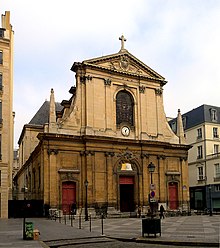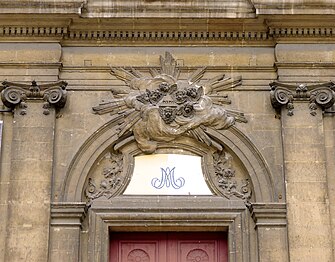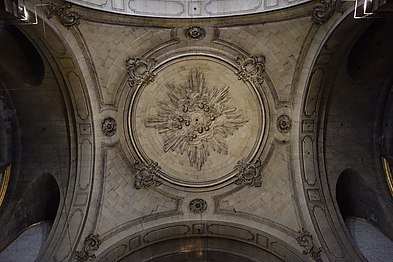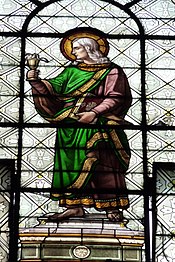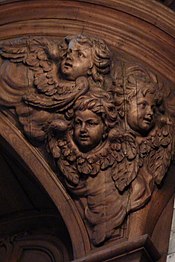
The Basilica of Sacré Cœur de Montmartre, commonly known as Sacré-Cœur Basilica and often simply Sacré-Cœur, is a Catholic church and minor basilica in Paris dedicated to the Sacred Heart of Jesus. It was formally approved as a national historic monument by the National Commission of Patrimony and Architecture on December 8, 2022.

Rouen Cathedral is a Catholic church in Rouen, Normandy, France. It is the see of the Archbishop of Rouen, Primate of Normandy. It is famous for its three towers, each in a different style. The cathedral, built and rebuilt over a period of more than eight hundred years, has features from Early Gothic to late Flamboyant and Renaissance architecture. It also has a place in art history as the subject of a series of impressionist paintings by Claude Monet, and in architecture history as from 1876 to 1880, it was the tallest building in the world.

The Basilica of the Sacred Heart in Notre Dame, Indiana, is a Catholic church on the campus of the University of Notre Dame, also serving as the mother church of the Congregation of Holy Cross (C.S.C.) in the United States. The neo-gothic church has 44 large stained glass windows and murals completed over a 17-year period by the Vatican painter Luigi Gregori. The basilica bell tower is 230 feet (70 m) high, making it the tallest university chapel in America. It is a contributing building in Notre Dame's historic district listed on the National Register of Historic Places. The basilica is a major tourist attraction in Northern Indiana, and is visited annually by more than 100,000 tourists.

The Church of Saint-Germain-des-Prés is a Catholic parish church located in the Saint-Germain-des-Prés quarter of Paris. It was originally the church of a Benedictine abbey founded in 558 by Childebert I, the son of Clovis, King of the Franks. The abbey was destroyed by the Vikings, rebuilt, and renamed in the 8th century for Saint Germain, a 6th century bishop. It was rebuilt with elements in the new Gothic style in the 11th century, and was given the earliest flying buttresses in the Ile de France in the 12th century. It is considered the oldest existing church in Paris.

The Church of St. Eustache, Paris, is a church in the 1st arrondissement of Paris. The present building was built between 1532 and 1633.

The Church of Saint-Germain l'Auxerrois is a medieval Roman Catholic church in the 1st arrondissement of Paris, directly across from the Louvre Palace. It was named for Saint Germanus of Auxerre, a medieval bishop of Auxerre, who became a papal envoy and met Saint Genevieve, the patron saint of Paris, on his journeys. Genevieve is reputed to have converted Queen Clotilde and her husband, French king Clovis I to Christianity at the tomb of Saint Germain in Auxerre.

Saint-Pierre de Montmartre is the second oldest surviving church in Paris, after the Abbey of Saint-Germain-des-Pres. It is one of the two main churches on Montmartre, the other being the more famous 19th-century Sacré-Cœur Basilica, just above it. Saint-Pierre de Montmartre, begun in 1133, was the church of the prestigious Montmartre Abbey, destroyed in the French Revolution.

The Église de la Sainte-Trinité is a Roman Catholic church located on the place d'Estienne d'Orves, at 3 rue de la Trinité, in the 9th arrondissement of Paris. It was built between 1861 and 1867 during the reign of Emperor Napoleon III, in the residential neighborhood of the Chaussée d'Antin. It is in the ornate Neo-Renaissance or Second Empire Style, with a highly visible 65-meter-tall belfry.

The Church of Saint-Merri or Église Saint-Merry) is a parish church in Paris, located near the Centre Pompidou along the rue Saint Martin, in the 4th arrondissement on the Rive Droite. It is dedicated to the 7th century abbot of Autun Abbey, Saint Mederic, who came to Paris on pilgrimage and later died there in the year 700. In 884 Mederic was declared patron saint of the Right Bank.

The Basilica of Saint Clotilde is a basilica church located on the Rue Las Cases, in the 7th arrondissement of Paris. It was constructed between 1846 and 1856, and is the first example of a church in Paris in the neo-Gothic style.
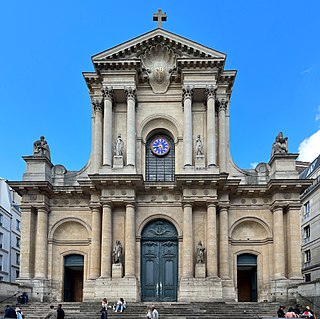
The Church of Saint-Roch is a 17th–18th-century French Baroque and classical style church in Paris, dedicated to Saint Roch. It is located at 284 rue Saint-Honoré, in the 1st arrondissement. The current church was built between 1653 and 1740.

Saint-Pierre de Montrouge is a Roman Catholic parish church located at 82 avenue du General Leclerc in the Petit-Montrouge quarter of the 14th arrondissement of Paris It occupies a triangular lot at the intersection of two major streets, the Avenue du Maine and the Avenue General-Leclerc. It was built in 1863 in the Neo-classical style. It was inscribed as an historic monument of Paris in 1982.

St Francis Xavier Church is a parish Roman Catholic church in the 7th arrondissement of Paris dedicated to Francis Xavier, the patron saint of missions. Built in the late 19th century, It gave its name to the nearby Metro station Saint-François-Xavier. It contains the tomb of Madeleine Sophie Barat, a French saint of the Catholic Church and founder of the Society of the Sacred Heart, a worldwide religious institute of educators. It is also known for its collection of Italian Baroque and Mannerist paintings, including a work by Tintoretto. The church was inscribed as an historic monument in 2018.
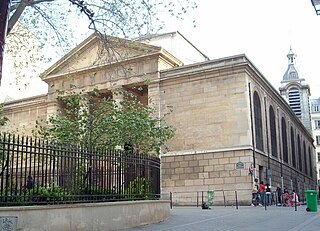
Notre-Dame-de-Bonne-Nouvelle, located at 25 Rue de la Lune, in the 2nd arrondissement of Paris and is a Catholic parish church built between 1823 and 1830. It is built in the Neoclassical style, and is dedicated to Notre-Dame de Bonne-Nouvelle, referring to the Annunciation. The neighbourhood of Bonne-Nouvelle, the Boulevard de Bonne-Nouvelle and the Bonne Nouvelle metro station are named after it. The church was registered as a national historical monument in 1983.

Notre-Dame-de-Lorette is a Roman Catholic church located in the 9th arrondissement of Paris, It was built between 1823 and 1836 in the Neo-classical architectural style by architect Louis-Hippolyte Lebas, in a neighbourhood known as the New Athens, for its many artistic and scholarly residents in the 19th century, including George Sand, Pierre-Auguste Renoir, and Alexandre Dumas. While the exterior is classical and austere, the church interior is known for its rich collection of paintings, sculpture, and polychrome decoration.

Notre-Dame-de-la-Croix de Ménilmontant is a Roman Catholic parish church located in Ménilmontant, in the 20th arrondissement of Paris, France. It was built between 1863 and 1880. Of exceptional height and length, it is one of the largest churches in Paris.
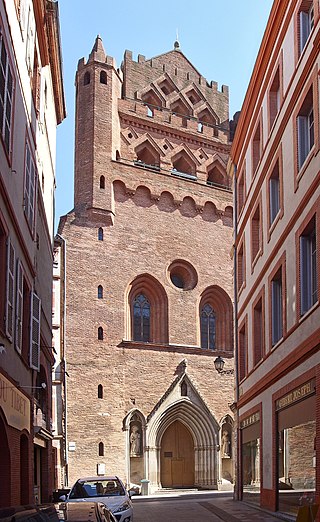
Notre-Dame du Taur is a Roman Catholic church located in Toulouse, France. According to legend, the edifice was built on the exact spot where the body of Saint Saturnin (Sernin), patron saint of Toulouse, became detached from the bull that dragged the martyr to his death. The church stands in the rue du Taur between the Capitole and the Basilica of St. Sernin. It has been classified as a historic monument since 1840.
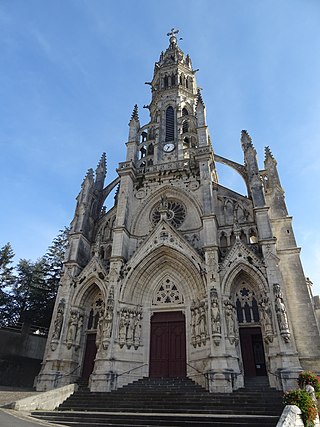
Basilica of Notre-Dame des Enfants is a minor basilica located in Châteauneuf-sur-Cher, France. The basilica is dedicated to Our Lady of the Children and is the seat of the Archbishop of Bourges. Built from 1869 until 1879, it is largely in the Neo-Gothic architectural style and was constructed at about the same time as Basilica of Notre-Dame de Fourvière.

Notre-Dame-de-la-Compassion is a Roman Catholic Church located on Place du Général Koenig in the 17th arrondissement in Paris. It was originally built in 1842–43 as a memorial chapel to Ferdinand Philippe, Duke of Orléans, the heir to King Louis-Philippe of France, who was killed in a road accident in 1842. It was built in the Neo-Byzantine style, with elements of Gothic, Baroque and other styles, and was originally called the Chapelle Royale Saint-Ferdinand. In 1970 it was moved stone by stone from its original location a short distance away to make space for the new Palais des Congrès. It became a parish church in 1993. Its notable decoration includes stained glass windows designed by Jean-Auguste-Dominique Ingres, and sculpture by Henri de Triqueti. It was designated a French historic monument in 1929.

The Church of Saint-Denys-de-Saint-Sacrament is a Roman Catholic church located in the Marais quarter, at 68 Rue de Turenne in the 3rd arrondissement of Paris, France. It was constructed between 1826 and 1835, It took its name from Saint Denys, the first bishop of Paris, and from the church of the Benedictines of the Perpetual Order of the Saint Sacrament, which had previously occupied the site. The early church was too small for the growing congregation and was replaced by the larger present church. It is an example of Neoclassical architecture, a style very popular in Paris the first half of the 19th-century.
